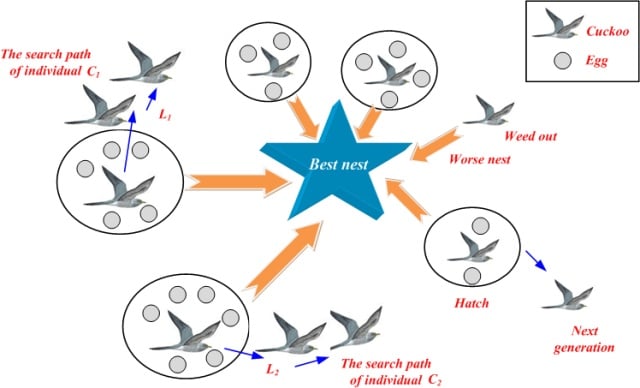1. 简介
Cuckoo Search(布谷鸟搜索)算法是一种基于种群的元启发式优化算法,灵感来源于布谷鸟(Cuckoo)的寄生繁殖行为。该算法结构简单、参数少,仅需设置一个关键参数 $Pa$,因此实现和调优相对容易。
它在多个领域中都有成功应用,例如:
- 云计算中的成本与安全优化
- 天线阵列设计
- 特征选择(Feature Selection)
- 数据挖掘与模式识别
- 软件测试优化
本文将带你深入理解 Cuckoo Search 算法的核心思想、实现步骤,并通过伪代码和实际应用案例帮助你掌握其使用方式。
2. 什么是元启发式算法(Metaheuristics)
元启发式算法是一类通用的优化算法,用于在复杂问题空间中寻找近似最优解。它们不像传统的启发式算法那样针对特定问题设计,而是具有更强的通用性。
✅ 特点如下:
- 不依赖具体问题的数学模型
- 适用于多种优化问题(如 NP 难问题)
- 能跳出局部最优,寻找全局最优解
- 具有随机性,避免陷入局部最优
⚠️ 注意:元启发式算法不能保证找到最优解,但能在合理时间内找到一个高质量的可行解。
3. Cuckoo Search 算法原理
Cuckoo Search 由 Xin-She Yang 和 Suash Deb 于 2009 年提出,灵感来源于布谷鸟将蛋产在其他鸟类巢穴中,由宿主代为孵化的繁殖行为。
核心思想:
- 每个“巢”代表一个可能的解(solution)
- 每个“蛋”代表当前解的一个变体(新解)
- 如果宿主发现外来蛋(新解更优),就会替换原巢中的解
- 一些质量较差的巢会被以一定概率 $Pa$ 丢弃并重建
算法特点:
✅ 收敛速度快
✅ 参数少,易于实现
✅ 可用于连续、离散、混合优化问题
算法流程图:

4. Cuckoo Search 算法步骤详解
4.1 初始化
生成初始种群,即一组随机解(巢),数量为 $n$。
4.2 利维飞行(Levy Flight)
这是 Cuckoo Search 的核心机制之一,用于生成新解。
Levy 飞行是一种具有长尾分布的随机游走方式,其步长满足以下公式:
$$ x_{i}^{t+1} = x_i^t + \alpha \oplus \text{Levy}(\lambda) $$
其中:
- $x_i^t$ 是第 $i$ 个解在第 $t$ 步的位置
- $\alpha$ 是步长因子(常设为 1)
- $\oplus$ 表示逐元素相乘
- $\text{Levy}(\lambda)$ 是服从 Levy 分布的随机数
Levy 飞行有助于在解空间中进行大范围探索,避免陷入局部最优。
4.3 适应度计算(Fitness Calculation)
对每个新解(即“布谷鸟蛋”)计算其适应度值,并与随机选择的巢中的解进行比较:
- 如果新解适应度更高,则替换原巢
- 否则保留原巢
4.4 终止条件
重复上述步骤直到达到最大迭代次数。每轮迭代中,保留当前最优解。算法终止时输出全局最优解。
5. 伪代码实现
algorithm CuckooSearch():
// INPUT
// n = 初始种群大小(巢的数量)
// Pa = 被淘汰巢的比例
// MaxIterations = 最大迭代次数
// f = 待优化的目标函数
// OUTPUT
// 最优解
初始化种群:生成 n 个随机解(巢)X_i (i=1..n)
t ← 0
while t < MaxIterations:
随机选择一个布谷鸟个体,通过 Levy 飞行生成新解
计算新解的适应度值 F_cuckoo
j ← 随机选择一个巢 j
if F_cuckoo > F_j:
用新解替换巢 j
按照概率 Pa 丢弃部分劣质巢,生成新随机解替代
保留当前最优解
t ← t + 1
返回当前最优解
📌 提示:完整实现可参考 Python 和 Matlab 的开源实现:
6. 应用场景与案例
6.1 云计算安全与成本优化
在云环境中,使用 Cuckoo Search 算法可同时优化:
- 成本(如资源使用费用)
- 安全性(减少漏洞与攻击面)
通过调整节点之间的距离,降低攻击者成功利用漏洞的可能性。
6.2 天线阵列设计
Cuckoo Search 被用于优化天线阵列参数,包括:
- 各个天线单元的电流幅度与相位
- 单元之间的间距
目标是:
- 降低旁瓣(Side Lobes)
- 在特定方向形成零点(Null Control)
适用于卫星通信、潜艇通信等高精度通信场景。
6.3 特征选择(Feature Selection)
在机器学习中,特征选择是提升模型性能的重要预处理步骤。Cuckoo Search 可用于:
- 减少冗余特征
- 提升分类准确率
- 缩短训练时间
采用二进制向量表示特征选择状态:
- 1 表示选中该特征
- 0 表示不选中
7. 总结
Cuckoo Search 是一种高效、简洁的元启发式优化算法,凭借其少参数、易实现、收敛快的特点,广泛应用于多个领域。它通过模拟布谷鸟的繁殖行为,在解空间中进行高效搜索。
✅ 优点总结:
- 参数少,便于调参
- 易于实现,可扩展性强
- 全局搜索能力强
❌ 缺点:
- 无法保证找到全局最优解
- 对目标函数敏感,可能需要多次运行取平均
如果你正在寻找一个结构简单但性能优异的优化算法,Cuckoo Search 是一个非常值得尝试的选择。